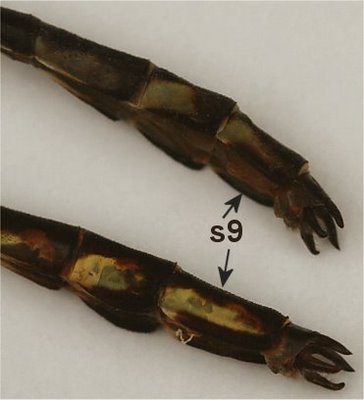We were once again on the hunt for hanging clubtails. We saw only one Russet-tipped Clubtail, but were hopeful to voucher Arrow Clubtail (Stylurus spinceps). And both of us had seen some smaller, dark Stylurus in these recent trips, and the candidate foremost in our minds was, S. notatus, Elusive Clubtail. Typically a treetop dweller, they are...elusive. The only county records were two larval specimens taken in 1984 from the Detroit River at Grosse Ile. The distance between the Humbug brownfield and Grosse Ile can be measured in yards.
After an hour or so of wandering, I got a radio call from Stylurus that he had nabbed a male Stylurus. When I looked at it, I was pretty sure it was not S. spinceps, it did not seem large enough. And the teal-blue eyes sure looked familiar to me. We had netted a female notatus in Wisconsin some years ago. I trotted it over to Mark, who confirmed the genus and thought it was probably spiniceps. We had nets and camera gear up the ying-yang, but no gomphid genitalia cheat sheets, so we continued our exploration until we were once again caught by rain.
Back home, a quick look at the hamules and length of abdominal segment 9 confirmed my initial hunch: this was Stylurus notatus. In the photo below, check out the long hamule on the reference specimen of S. spiniceps on the top, compared to the small, pointy hamule on the S. notatus below it.
 Spiniceps also has a very long segment 9, around 1.25 times longer than s8, while these two segments are about the same length in notatus. Below, notatus is on top.
Spiniceps also has a very long segment 9, around 1.25 times longer than s8, while these two segments are about the same length in notatus. Below, notatus is on top. This is the first adult specimen for Wayne County, and only the ninth adult specimen for the state. Elusive Clubtail is a species of special concern for Michigan, so we consider it a great success that we have confirmed it for the Refuge. Finding these insects will help guide management and restoration, and it's also good to know that after 22 years, the Detroit River is still supporting S. notatus.
This is the first adult specimen for Wayne County, and only the ninth adult specimen for the state. Elusive Clubtail is a species of special concern for Michigan, so we consider it a great success that we have confirmed it for the Refuge. Finding these insects will help guide management and restoration, and it's also good to know that after 22 years, the Detroit River is still supporting S. notatus.Plus, it was a blast to be out with another couple that shares our love of insects, field work, and natural history. We vowed to make further trips together next field season!
